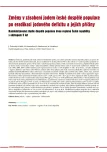Testosterone and therapy of myasthenia
Authors:
L. Stárka
Authors‘ workplace:
Endokrinologický ústav, Praha, ředitel doc. MUDr. Vojtěch Hainer, CSc.
Published in:
Vnitř Lék 2006; 52(10): 909-911
Category:
Review
Overview
Testosterone increases muscle mass and decreases fat mass by mechanism including androgen receptors. Testosterone induces skeletal muscle fibre hypertrophy and increases the number of satellite cells. It also promotes the differentiation of mesenchymal multipotent cells into myogenic lineage and inhibits their differentiation into the adipogenic lineage. Meta-analyses of clinical trials provide evidence that testosterone treatment increases in dose dependent manner skeletal muscle mass and to some degree also muscle strength. The most frequent adverse effects of testosterone treatment in aging men are an increase of hematocrit and increased risk of prostate events.
Key words:
testosterone - muscle mass - muscle strength - adverse effects - sarcopenia
Sources
1. Basaria S, Dobs A. Andropause: to treat or not to treat? J Endocrinol Invest 2003; 26: 693-697.
2 Bhasin S, Taylor WE, Singh RL et al. The mechanismus of androgen effects on body composition: mesenchymal pluripotent cell as the target of androgen action. J Gerontol A Biol Sci Med Sci 2003; 58: M1103-M1110.
3. Bhasin S. Regulation of body composition by androgens. J Endocrinol Invest 2003; 26: 814-822.
4. Bhasin S, Calof OM, Storer TW et al. Drug insight: testosterone and selective androgen receptor modulators as anabolic therapies for chronic illness and aging. Nature Clin Pract Endcor Metab 2006; 2: 146-159.
5. Calof OM, Singh AB, Lee MI et al. Adverse events associted with testosterone replacement in middle-aged and older men: a meta-analysis of randomized, placebo-controlled trials. J Gerontol A Biol Med Sci 2005; 60: 1451-1457.
6. Chaloupka V, Elbl L, Nehyba S. Silový trénink u nemocných po infarktu myokardu. Vnitř Lék 2000; 46: 829-838.
7. Kamel HK. Sarcopenia and aging. Nutr Rev 2003; 61: 157-167.
8. Singh R, Artraza JW, Taylor WE et al. Androgens stimulate myogenic differentiation and inhibit adipogenesis in C3H 10T1/2 pluripotent cells through an androgen receptor-mediated pathway. Endocrinology 2003; 144: 5081-5088.
9. Singh R, Artraza JW, Taylor WE et al. Testosterone inhibits adipogenic differentiation in 3T3-L1 cells. Nuclear translocation of androgen receptor complex with β-catenin and TCF4 may bypass canonical Wnt signaling to downregulate adipogenics transcription factors. Endocrinology 2006; 147: 141-154.
10. Sinha-Hikim I, Artraza J, Woodhouse L et al. Testosterone-induced increase in muscle size in healthy young men is associated with muscle fiber hypertrophy. Am J Physiol Endocrinol Metab 2002; 283: E154-E164.
11. Sinha-Hikim I, Roth SM, Lee MI et al. Testosterone-induced muscle hypertrophy is associated with an increase in satellite cell number in healthy, young men. Am J Physiol Endocrinol Metab 2003; 285: E197-E205.
12. Stárka LCo lze očekávat od léčby andropauzy testosteronem? DMEV 2004; 7(Suppl 2): 49-52.
Labels
Diabetology Endocrinology Internal medicineArticle was published in
Internal Medicine

2006 Issue 10
Most read in this issue
- Hashimoto’s encephalopathy
- Radionuclid screening in endocrinology
- Autoimmune thyroiditis - selected etiopathogenic mechanisms
- Congenital adrenal hyperplasia due to 3-β-hydroxysteroid dehydrogenase deficiency
